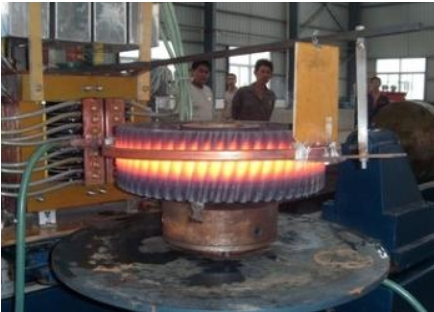- 13
- Sep
Quenching equipment

Quenching equipment
Quenching equipment is mainly divided into medium frequency quenching furnace (medium frequency quenching equipment), high frequency quenching furnace (high frequency quenching equipment), CNC quenching machine tool, and integrated quenching machine tool. Quenching equipment is mainly composed of three parts: quenching machine tool, medium and high frequency power supply, and cooling device; the quenching machine tool consists of bed, loading and unloading mechanism, clamping, rotating mechanism, quenching transformer and resonance tank circuit, cooling system, quenching liquid circulation system, The quenching machine is generally composed of electrical control system, and the quenching machine is generally single station; the quenching machine has two types of structure, vertical and horizontal. The user can choose the quenching machine according to the quenching process. For special parts or special processes, according to the heating process It is required to design and manufacture special hardening machine tools.
Working principle of quenching equipment:
The working principle of the quenching equipment is: the workpiece is placed in the inductor, which is generally a hollow copper tube with medium frequency or high frequency alternating current (1000-300000Hz or higher). The alternating magnetic field generates an induced current of the same frequency in the workpiece. The distribution of this induced current on the workpiece is uneven. It is strong on the surface but weak on the inside. It is close to 0 to the core. Use this skin effect , The surface of the workpiece can be heated quickly, and the surface temperature will rise to 800-1000ºC within a few seconds, while the temperature of the core will increase very little.
Characteristics of quenching equipment
1. Using IGBT as the main device and full-bridge inverter.
2. Designed with 100% load continuity rate, it can work continuously.
3. It can be remotely controlled and connected to infrared temperature measurement to realize automatic temperature control, improve heating quality and simplify worker operations.
4. Replace heating methods such as oxyacetylene flame, coke furnace, salt bath furnace, gas furnace, oil furnace, etc.
5. Automatic frequency tracking and multi-circuit closed-loop control are adopted.
6. Power saving: 30% power saving than electronic tube type, 20% power saving compared to thyristor mid-frequency.
7. Stable performance: complete protection and no worries.
8. Fast heating speed: no oxide layer, small deformation.
9. Small size: light weight and easy to install.
10. The inductor is isolated by a transformer for safety.
11. Environmental protection: no pollution, noise and dust.
12. Strong adaptability: It can heat all kinds of workpieces.
13. The temperature and heating time can be accurately controlled, and the processing quality is high.
Application areas of quenching equipment
Welding
1. Welding of diamond cutter heads, welding of carbide saw blades and welding of diamond cutting tools, abrasive tools and drilling tools.
2. Welding of cemented carbide tools for machining. Such as the welding of cutting tools such as turning tools, planers, milling cutters, reamers, etc.
3. Welding of mining tools, such as “one” bit, cross bit, column tooth bit, dovetail coal bit, riveting rod bit, various shearer picks, and various roadheader picks.
4. Welding of various woodworking tools, such as various woodworking planers, milling cutters and various woodworking drill bits.
Forging and rolling
1. Hot rolling and heating of various twist drills.
2. Hot heading heating of standard parts and fasteners, such as high-strength bolts, nuts, etc.
3. Heating of tempering, forging and extrusion of brazing steel and brazing tools.
4. Heating before forging of various machinery, automobile and motorcycle parts.
Heat treatment
1. Heat treatment of various hardware tools and hand tools. Such as pliers, wrenches, screwdrivers, hammers, axes, knives, etc.
2. High-frequency quenching treatment for various auto parts and motorcycle parts. Such as: crankshaft, connecting rod, piston pin, crank pin, ball pin, sprocket, camshaft, valve, various rocker arms, rocker shaft; various gears, spline shafts, transmission half shafts, various Kinds of small shafts, various shift forks and other high-frequency quenching treatments.
3. High-frequency quenching treatment of gears and shafts on various electric tools.
4. High-frequency quenching heat treatment of various hydraulic components and pneumatic components. Such as the column of a plunger pump.
5. The rotor of the plug and the rotor pump; the quenching treatment of the reversing shaft on various valves and the gears of the gear pump.
6. Heat treatment of metal parts. Such as high-frequency quenching treatment of various gears, sprockets, various shafts, spline shafts, pins, etc.
7. High-frequency quenching treatment of valve discs and stems of various safety valves and forged steel valves.
8. Quenching treatment of machine tool bed rails and gears in the machine bed in the machine tool industry.
